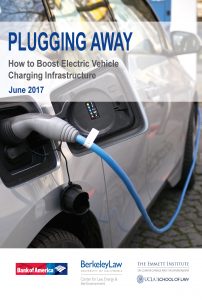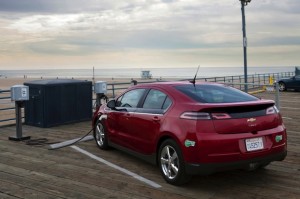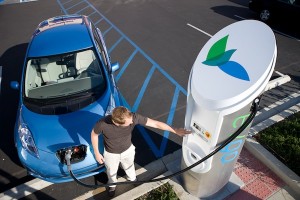Recently I discussed the sad state of electric vehicle charging infrastructure, given the current and projected demand for charging stations in workplaces, multifamily buildings, and fast-charge “plazas.” I spoke about the need on KALW’s Your Call radio on Monday as well.
 But could hope be around the corner? I was encouraged to see that General Motors, as part of their announcement this week committing to new EV models, will also be building more charging stations.
But could hope be around the corner? I was encouraged to see that General Motors, as part of their announcement this week committing to new EV models, will also be building more charging stations.
It can’t come soon enough. While the Chevy Bolt EV has a useful range of 238 miles per charge (at an affordable price of near $30,000 with incentives), the infrastructure doesn’t exist to support most long-range trips. For example, Bolt EV drivers between Los Angeles and San Francisco, two major markets in the heart of the biggest EV market of California, can’t fast-charge on the major interstate connecting them. GM should do everything it can to fill that gap and others like it.
Meanwhile, electric utilities are gearing up to invest $1 billion in infrastructure, once they finalize the regulatory proceeding in California. And the Volkswagen diesel emissions cheating scandal settlement will steer $800 million for charging stations toward the state in the next 10 years.
All together, reason for optimism that will make progress overcoming the charging station shortage. It can’t come soon enough.
 Though the future of electric vehicles remains murky at the federal level, due to Donald Trump’s hostility to climate science and love of oil and gas, the industry will receive a big boost from two companies this holiday season: California electric utilities and Volkswagen.
Though the future of electric vehicles remains murky at the federal level, due to Donald Trump’s hostility to climate science and love of oil and gas, the industry will receive a big boost from two companies this holiday season: California electric utilities and Volkswagen.
Volkswagen has agreed to a partial settlement from its emissions-cheating scandal, which could bring huge dividends to California if it’s enforced properly:
To mitigate environmental harm from their actions, the companies must pay $225 million into a national mitigation fund. California will receive about $41 million of that money for mitigation programs in the state designed to address the additional NOx emissions released by the vehicles in question. This is in addition to $1.2 billion VW is already paying California for mitigation and zero-emission vehicle (ZEV) infrastructure as part of the 2-liter partial consent decree.
The settlement, together with a previous consent decree, also requires the company to fund two “Green Cities” in California, which must have populations of at least 500,000 with many living primarily in disadvantaged communities. These cities will receive “concentrated investment in ZEV programs like car sharing, ZEV transit or freight services and infrastructure and public awareness efforts to support those programs.”
An additional $25 million dollars will support programs such as “replace-and-upgrade programs for high-emitting cars in disadvantaged communities (EFMP Plus-up) and the Clean Vehicle Rebate Project (CVRP), which provide rebates and financial assistance for purchase of ZEVs.”
But perhaps most significantly, California consumers can expect new models of EVs to be fast-tracked:
[T]he manufacturers will provide at least three new models of electric vehicles for sale in California — including at least one SUV model — before 2019. The companies must add a second electric SUV model by 2020 and keep these electric models on the market through at least 2025. ZEV credits generated by placement of these vehicles in California cannot be sold on the ZEV credit market.
All in all, these provisions will definitely provide a major shot in the arm for the industry. As E&E news reports [paywall]:
Analysts say that in the early years of the investment, Volkswagen could nearly double the money spent on construction of EV charging infrastructure, seen as a way to spark more sales. States, cities and private companies are scrambling to get a piece of the Volkswagen pie.
“It’s just so much money,” said Ashley Horvat, vice president of strategic initiatives at PlugShare, an EV charging firm. “It will lay the groundwork for the future, and everybody is waiting to see how they fit into that future.”
Of course, some of the existing charging industry companies are afraid this investment will crowd out competition, while others worry it will allow Volkswagen to gain a monopoly advantage in a new industry — hardly a punitive outcome given the company’s malfeasance.
They also worry it may overshadow recently approved electric utility investment in charging infrastructure. California regulators are finally letting these utilities get into the charging game, as E&E reports:
Last Friday, the California Public Utilities Commission approved a plan by the Pacific Gas and Electric Co. to build 7,500 EV charging stations in its Northern California territory. Ratepayers will shoulder the $130 million cost. It is the third major Californian utility to have an EV charging plan approved, after Southern California Edison and San Diego Gas & Electric.
All in all, states and private companies are (no pun intended) charging ahead with electric vehicles. This momentum may be necessary come January, when the new administration and its oil-and-gas allies in Congress could create some major headwinds for this vital industry.
I suggested a few weeks ago that the state punish Volkswagen by requiring them to support electric vehicle deployment, and apparently a bunch of clean technology folks like Elon Musk agree with me. They wrote a letter to the California Air Resources Board urging them to impose a zero-emission vehicle credit buying requirement on VW, as well as mandating that they build EVs here in California.
Of course it’s in Musk’s business interest to propose this idea, but I think it makes sense. It may not satisfy consumer advocates burned about customers now driving defective products, or environmental justice advocates upset about the localized pollution from these cheating vehicles. But look at the bigger picture: investment now in electric vehicles will bring down their cost, allowing most people in California to buy one by 2030 or sooner and cleaning the air and climate in the process.
My only concern, as I voiced in the original blog post, is that California has not proven to be effective at negotiating these “punishments.” The eVgo settlement requiring more electric vehicle chargers has been just short of a disaster, and it’s not clear anyone in state government is learning any lessons from that experience. But in concept, the idea makes sense for the California economy and environment, as well as for the affected communities.
The Volkswagen emissions cheating scandal is another sad example of corporate malfeasance. For those not following the story, the basics are as follows: Volkswagen secretly installed “defeat devices” on approximately 11 million vehicles worldwide that could detect when the cars were being tested for emissions and then reduce the emissions to avoid being penalized. While the vehicles performed well during laboratory testing, in reality the emissions were up to 40 times the legal limit. You can see the map of affected areas from the pollution via Grist here.
So what remedies should California, as the state most immediately affected, seek from VW? At a minimum, state leaders should use the opportunity to bolster reduced emissions from vehicles going forward. And that means improving the deployment of battery electric technologies in vehicles.
California has gone down this path before. When Enron and other energy companies defrauded electricity ratepayers with the rolling black-outs in California back in 2000 and 2001, the state eventually settled with NRG, the corporate entity that assumed the liability through corporate acquisitions. State negotiators required that NRG spend $100 million on electric vehicle charging infrastructure.
But that settlement has so far not worked out well. NRG is way behind schedule and state auditors are investigating what’s going on. So state leaders need to learn from that experience and find a more direct way for VW to pay for its malfeasance and pollution.
A relatively simple way to do it would be to require VW, via settlement terms, to purchase a set amount of “zero emission vehicle (ZEV)” credits from automakers making battery electrics. That would boost their supply and reduce the costs of electric vehicles. Or VW could pay into a fund that reduces the cost of purchasing or leasing electric vehicles, via a point-of-sale cash rebate, for example. And to be clear, these requirements should not be the only settlement terms, but the ones directly related to repairing the harm to the environment from this cheating.
Of course, we have years of litigation to come on this scandal. But state leaders should start thinking now about how to make some lemonade out of these bitter VW lemons, while learning from past experiences.
 Good news for those who can’t afford a Tesla but want to or currently drive a battery electric:
Good news for those who can’t afford a Tesla but want to or currently drive a battery electric:
The [charging] stations will be built and operated by ChargePoint, the nation’s largest charging provider, which already has about 20,000 stations in place. Prices vary, but about $.50 per kilowatt-hour is standard, which means “filling” the e-Golf will run you 12 bucks if you’ve managed to completely drain the 24 kwHr pack.
In the east, the network will let drivers go from Boston to Washington on I-95. Out west, you’ll be able to drive from Portland, Oregon, to San Diego. The stations will offer 50-kW fast chargers, which can get most EVs up to 80 percent charge in 30 minutes, and slower 24-kW Level 2 stations.
It’s great to see the automakers collaborating like this, and the charging stations will be open to any compatible EV car (unlike Tesla’s network, which only works on Tesla batteries). It’s also badly needed given the slow pace of infrastructure deployment here in California. EVgo is using state settlement money from the “rolling blackouts” of the turn-of-the-century, but the charger rollout is slow and mostly focused within urban areas, as opposed to between them. So we need those fast chargers on key highways between major cities, or else all-battery EVs of the 80-mile range variety are basically stuck as commuter cars.


